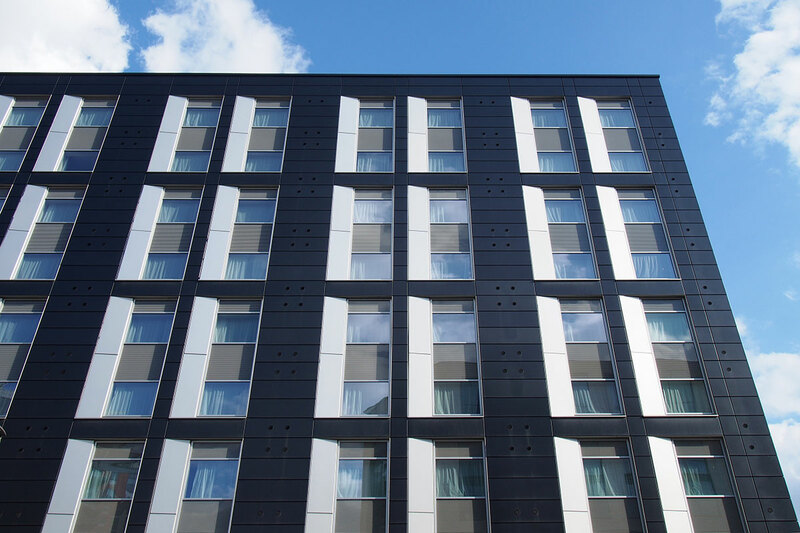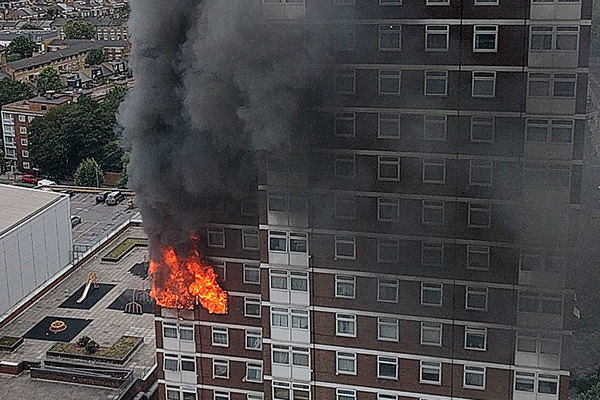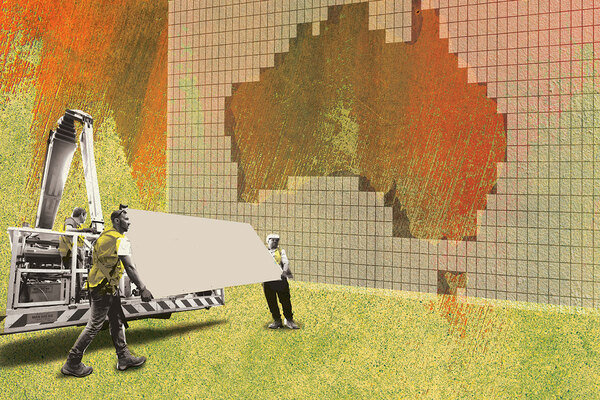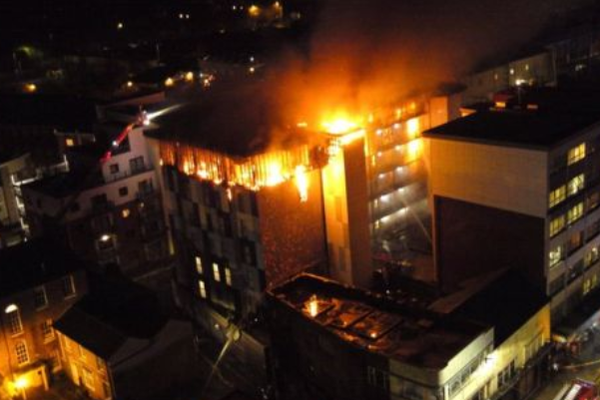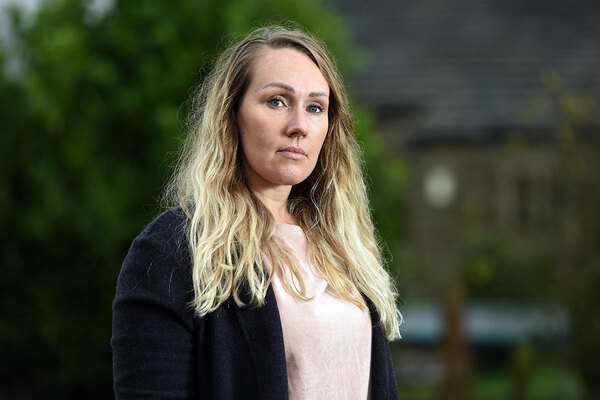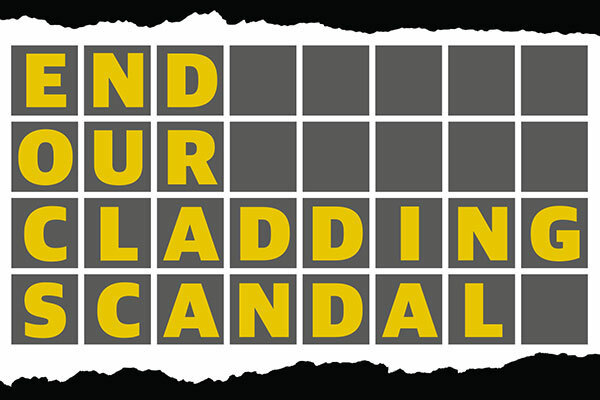More than 100,000 medium-rise buildings outside scope of fire safety measures, minutes reveal
There are more than 100,000 medium-rise homes that fall outside new regulations aimed at making buildings safe in the aftermath of Grenfell, including the ban on combustible cladding, Inside Housing can reveal.
Leaked minutes from a meeting between local authority figures and government officials have shown that lowering the official threshold for a ‘high-rise building’ to 11m would raise the current number of buildings in scope from 12,000 to more than 100,000.
These buildings, which can be up to seven storeys tall, sit outside requirements to remove dangerous cladding, as well as newer recommendations to provide fire alarms and write evacuation strategies.
The ban on the use of combustible materials also only applies from 18m – meaning new buildings can currently be built with combustible cladding in compliance with government guidance.
The Cube in Bolton, which was ravaged by fire ripping through combustible high-pressure laminate panels last weekend, measured 17.86m, meaning it slipped narrowly below this threshold.
A huge fire that tore through combustible timber cladding in Barking, east London, in June also occurred in a building below 18m.
Industry sources said that builders have deliberately designed projects to narrowly below 18m to circumvent the regulatory requirements that kick in above that threshold.
Scotland recently changed regulations to reduce the threshold to 11m. Sir Martin Moore-Bick, chair of the Grenfell Tower Inquiry, said last month that he would consider recommending such a change in phase two of the inquiry.
It comes as Inside Housing updates its End Our Cladding Scandal campaign ahead of the general election. The campaign calls for a national taskforce to prioritise the building safety work required after Grenfell and a building safety fund that could be used for any tower with serious safety issues, regardless of height.
Funding is currently restricted to buildings with aluminium composite material cladding above 18m only.
The minutes obtained by Inside Housing record a meeting between representatives of London boroughs and government officials held in September.
“There are 12,000 existing buildings over 18m… should we lower the building height to 11m, the number will go up to over 100,000,” they read.
Paul Bussey, CDM and fire lead at AHMM Architects and a member of the expert panel on fire safety at the Royal Institute of British Architects, said: “There are people who are gaming the system by limiting buildings to six storeys.
“We are pretty convinced [at RIBA] that the combustibles ban should come down to 11m, if not all buildings. Why put combustible cladding on any building?”
Jonathan O’Neill, managing director at the Fire Protection Association, said he had also heard about the practice of designing below 18m to avoid the ban.
He added that the system should be reformed to prioritise safety based on risk – such as the number of occupants and their vulnerability – rather than simply height.
“If you take the Crewe care home fire [Beechmere Care Home], there were 120 elderly residents present. There is no way any height parameter would have applied to that building,” he said.
One other industry source said that if the threshold was not reduced, the effect of the post-Grenfell regulations would simply be “a new generation of buildings narrowly below 18m in height”.
Inside Housing’s End Our Cladding Scandal campaign, run in partnership with leaseholders of affected buildings, calls on the next government to take control of the cladding crisis at a national level.
It is supported by Grenfell United, the Fire Brigades Union, the National Housing Federation, the Chartered Institute of Housing and many others.
The Ministry of Housing, Communities and Local Government was unable to comment because of the election.
The Conservative Party did not respond to requests for comment.
End Our Cladding Scandal general election campaign: full coverage
The cladding scandal is far from over. Here’s why we need a fresh approach
Click here to read the full story
Ahead of the general election, Inside Housing revisits our national cladding scandal and sets out what needs to be done to prevent any further tragedies. Peter Apps reports.
The cladding crisis Down Under: what we can learn from the response to Grenfell in Australia
Click here to read the full story
Five years ago a fire spread up Grenfell-style ACM cladding on a high-rise in Melbourne. This prompted an overhaul of the Australian state of Victoria’s building safety regime. Peter Apps finds out what the UK could learn.
More than 100,000 buildings outside scope of fire safety measures, minutes reveal
Click here to read the full story
There are more than 100,000 medium-rise homes that fall outside new regulations aimed at making buildings safe in the aftermath of Grenfell, including the ban on combustible cladding, Inside Housing can reveal.
It’s only a matter of time until the next Bolton unless the parties step up to the plate on fire safety
Click here to read the full story
Inside Housing’s new election campaign calls on the main political parties to commit to taking action to prevent what currently seems like an inevitable further tragedy. It’s time for everyone to step up, writes Martin Hilditch.
Leaseholders fear missing out on £200m cladding fund as bidding deadline approaches
Click here to read the full story
Leaseholders living in blocks seeking government funding for the removal of Grenfell-style cladding have raised concerns over meeting the deadline for applications, while criticising the lengthy process being run by the government.
Government refusing to test polystyrene panels, despite request from London boroughs
Click here to read the full story
The government has no further plans to carry out testing of cladding products despite a specific request from London boroughs to test systems comprising polystyrene, a document obtained by Inside Housing has revealed.
End Our Cladding Scandal: campaign asks
The next government must:
- Create a ‘building safety fund’ to help pay for the necessary remediation work to affected buildings in the social and private sector – not just those with ACM cladding and above 18m
- Set up a taskforce, with the involvement of residents, capable of inspecting buildings, prioritising and ordering work and ensuring leaseholders are protected from unnecessary costs
